
Für eine deutsche Übersetzung dieser Seite einfach die Brandenburger Flagge anklicken
 |
Click the Brandenburg Flag for a German translation Für eine deutsche Übersetzung dieser Seite einfach die Brandenburger Flagge anklicken |


|
|
CometsA collection of pictures of comets taken by space probes. |
|


  Artist's conception of ICE (top left),
Giotto (bottom left),
Artist's conception of ICE (top left),
Giotto (bottom left),Vega 1 and Vega 2 (top right), Suisei and Sakigake Source: wordpress.com |
Halley's Comet comes close to the sun every 75-76 years. The comet's "visits"
have been recorded many times, the first time in 240 BC.
 At Halley's return in 1986, earth was ready and sent a whole Armada of space probes to
investigate the most famous of all comets. Two Soviet and two Japanese probes passed the comet to fine-tune the passage of ESA's
Giotto spacecraft, which passed Halley's nucleus at a distance of only 350 miles
on March 13 1986.
At Halley's return in 1986, earth was ready and sent a whole Armada of space probes to
investigate the most famous of all comets. Two Soviet and two Japanese probes passed the comet to fine-tune the passage of ESA's
Giotto spacecraft, which passed Halley's nucleus at a distance of only 350 miles
on March 13 1986.
 Here are our favorite
pictures of comets taken by spacecraft. Like our other space galleries, the pictures have not been selected because
of their scientific significance but because of their esthetic value and sometimes because of their historical importance.
Here are our favorite
pictures of comets taken by spacecraft. Like our other space galleries, the pictures have not been selected because
of their scientific significance but because of their esthetic value and sometimes because of their historical importance.
|

Hubble: Shoemaker–Levy 9 |

 Panoramic Hubble image of a train of 21 fragments of Shoemaker–Levy 9
Panoramic Hubble image of a train of 21 fragments of Shoemaker–Levy 9May 17, 1994; Source: NASA |

 Impact areas on Jupiter's southern hemisphere
Impact areas on Jupiter's southern hemisphereJune 1994; Source: Wikipedia |

|
The first time a space probe took a closer look at a comet was in 1994, when broken up pieces of comet
D/1993 F2 Shoemaker–Levy 9 crashed into Jupiter.
The comet had been captured by Jupiter's gravity some time in the 1960s or 1970. At its discovery in 1993, it was the first comet discovered in
The comet had been broken into pieces by Jupiter's gravitational pull in 1992. Between July 16 and 22, 1994, the fragments crashed into Jupiter's southern hemisphere leaving impact sites visible for months. The Hubble Space Telescope had a front-row seat to record the impact. The perhaps most exiting picture of the impact, however, was not taken by Hubble, but by the Mount Stromlo Observatory in Australia on July 18, 1994. The impact of comet fragment "G" - one of the larger pieces of the comet. A detailed account of the impact (including the picture to the right) can be found at at NASA's Stardust website. |

|

ICE: Giacobini-Zinner |
  Artist's conception of the International Cometary Explorer Source: Daniel Macháček |
The first direct encounter with a comet took place in 1985, when NASA's International Sun-Earth Explorer-3 received an extended
mission and was renamed the International Cometary Explorer (ICE).
ICE (then called ISEE-3) was launched on August 12, 1978. On November 20, 1978, it became the first spacecraft to be placed in a halo orbit at the L1 Earth-Sun Lagrangian point. ISEE-3 was part of the International Sun-Earth Explorer (ISEE) program, a joint effort by NASA and ESRO/ESA to study the interaction between the Earth's magnetic field and the solar wind. On June 10, 1982, the spacecraft left the Lagrangian point on a new mission. On September 11, 1985, it passed through the plasma tail of comet Giacobini-Zinner within about 4,800 miles of the nucleus. |

|
ICE delivered valuable data. However, it didn't have a camera so no pictures of the nucleus were taken. For this comet, we still rely on pictures taken on Earth, like the one to the right, taken on September 9, 2018 in the Moscow Region, Russia and published by Wikipedia. |

|


| Halley Armada: Halley |
| Then, in 1986, along came Halley. An Armada of five spacecraft passed the comet between March 6 and March 14. The Japanese probes Sakigake and Suisei passed through the tail, Suisei getting as close as 93,800 miles (151,000 km). |

  Vega probe and Halley's Comet on a Laotian stamp Source: dreamstime.com |
  Halley's nucleus from a distance of 5,523 miles Source: NASA |
  Halley's nucleus from a distance of 4,990 miles Source: astro-urseanu.ro |

|
Following the Japanese spacecrafts, the two Soviet Vega probes passed the comet in a distance of 5,523 miles (8,889km) and 4990 miles
(8,030 km), respectively, delivering the first image of a comet's nucleus on March 9, 1985. The four flybys were used to fine-tune the trajectory of ESA's Giotto probe, which on March 14, 1986 passed Halley's nucleus at a distance of only 120 miles (200 km) and delivered the first closeup picture of a comet's nucleus. |
  Artist's conception of the Giotto probe Source: Wikipedia |
  Composit image of Halley's nucleus with gas jets March 14, 1986; Source: ESA |


|
xxxxxxxxxxxxxxxxxxxxGiotto: Grigg–Skjellerup The close encounter with Halley knocked out Giotto's camera, so, on July10, 1992, when the probe passed comet 26P/Grigg–Skjellerup in a distance of only 124 miles (200 km), it could only record data but could not take pictures. The best picture of the comet (right) was taken on June 29, 1992 by the European Southern Observatory. |

|


Deep Space 1: Borelly |
|
NASA's Deep Space 1 was launched on October 24, 1998 and performed a flyby of asteroid 9969 Braille
on July 29, 1999. On an extended mission, the probe passed comet 19P/Borrelly on September 21, 2001. The probe passed the comet at a distance of 1,349 miles, close enough to actually pass through the comet's Coma, the nebulous envelope around the comet's nucleus. It transmitted what were, at the time, the best images and other science data from a comet. |
  Artist's conception of the Deep Space 1 probe Source: Wikipedia |
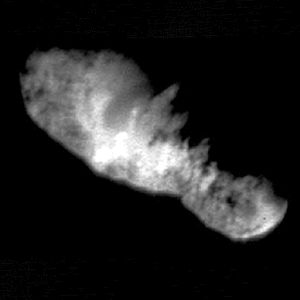  Borelly's nucleus, September 21, 2001 Source: Wikipedia |


Stardust: Wild 2 |
  Artist's conception of Stardust approaching the comet Source: Wikipedia |
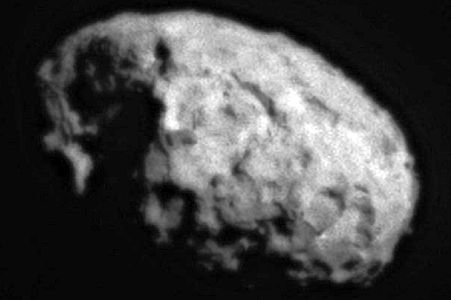  Wild 2's nucleus during closest approach, January 2, 2004 Source: NASA |
|
On February 7, 1999, NASA launched the Stardust probe on a sample return mission to
comet 81P/Wild 2. After passing asteroid Annefrank on November 2, 2002, Stardust passed Wild 2
on January 2, 2004 at a distance of 147 miles and collected dust particles of the comet's Coma. The probe's return capsule landed in Utah on January 15, 2006. With an entry velocity of 12.9 km/s (Mach 36) the capsule performed the fastest reentry speed into Earth's atmosphere ever achieved by a man-made object. After the Earth flyby, the probe was redirected to comet Temple 1, which had been visited by the Deep Impact spacecraft in 2005. Stardust passed Temple 1 on February 15 2011 (see next mission below).
|
  Nucleus, January 2, 2004 Source: NASA |
  Stardust Dust Collector Source: Wikipedia |
  Visible dust grains in the aerogel collector Source: Wikipedia |


Deep Impact, Stardust-NExT: Temple 1 |
|
On January 12, 2005, NASA launched Deep Impact, the first probe to actually make physical contact with a
comet. On July 4, 2005, the probe's Impactor successfully collided with the comet's nucleus. The impact excavated debris from the interior of the nucleus and created a dust cloud making further exploration by Deep Impact impossible. |
  Artist's conception of the Deep Impact spacecraft at Tempel 1. Source: Pat Rawlings, Planetary Society |
  Computer rendering of the Deep Impact space probe after separation of the impactor Source: Wikipedia |

  Composite image of Tempel 1's nucleus shortly before closest approach of Deep Impact July 4, 2005; Source: NASA / Planetary Society |
  Surface of Temple 1 taken by the impactor shortly before impact Source: NASA / Planetary Society |
  Picture taken by the Deep Impact spacecraft bjust seconds after the impact on July 4, 2005 Source: NASA / Planetary Society |


|

|

|

|

|
The Impact Above: Parts of a 30-frame animation of the impact, taken by the Flyby craft's high-resolution imager
Right: The impact as observed by the
Hubble Space Telescope
Below: The impactor created a crater of about 150 meters diameter.
|
 |

|

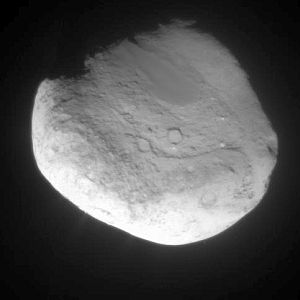  Tempel 1's nucleus 15 seconds before closest approach of Stardust February 15, 2011; Source: NASA / Planetary Society |

 Cmposite made from images obtained by Deep Impact and picture of the rim
Cmposite made from images obtained by Deep Impact and picture of the rimof the crater caused by the impactor (indicated by arrows), taken by Stardust Source: NASA / Planetary Society |


Deep Impact - EXPOSI: Hartley 2 |
|
After its groundbreaking visit of Temple 1, the Deep Impact spacecraft continued on an extended mission called
EPOXI. On November 4, 2010, the probe passed comet Hartley 2 in a distance of 431 miles. With a diameter of less than one mile, Hartley 2 is the smallest comet visited by a spacecraft so far. |
  Hartley 2 near the closest approach of Deep Impact Source: NASA / Planetary Society |
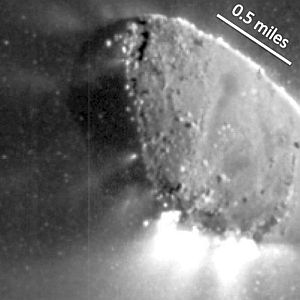  Nightside jets on Hartley 2 Source: NASA / Planetary Society |


Hubble: Borisov |
| On August 30, 2019, Crimean amateur astronomer Gennadiy Borisov discovered a new comet, that was first believed to be a near-Earth object. |

|
However, on September 8, 2019 a team of scientists led by astronomers from the Jagiellonian
University in Krakow, Poland determined that this comet was indeed the first observed interstellar comet, making it the second observed
interstellar
interloper after ʻOumuamua. It was thus classified as
2I/Borisov. First images of the object were obtained at the William Herschel Telescope on La Palma, Spain and on September 10, the larger Gemini North Telescope on Maunakea, Hawaii, delivered the first higher resolution multi-color images. On October 12, the Hubble Telescope took the first picture of an interstellar object taken by a space probe. |
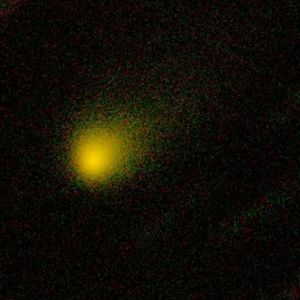  Gemini North Telescope, September 10, 2019 Source: Gemini Observatory / scitechdaily.com |
  Hubble Space Telescope, October 12, 2019 Source: Wikipedia |


Rosetta / Philae: Churyumov–Gerasimenko |
|
On March 2, 2004, ESA launched the Rosetta probe, which on August 6, 2014 became the
first spacecraft to actually enter into an orbit around a comet. On November 12, 2014, Rosetta's lander Philae touched down on comet 67P/Churyumov–Gerasimenko We have dedicated an extra page to this mission. |
 |

|


|
|
Click here to return to Ceres and Vesta | Click here to move on to Churyumov–Gerasimenko |
|

|
Back to Solar System Page |
Back to Space Page |
Back to English Main Page |
 Back to Start Page |